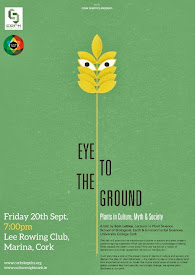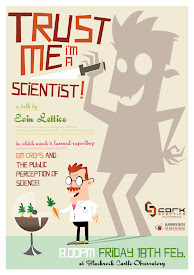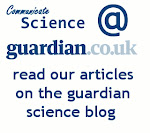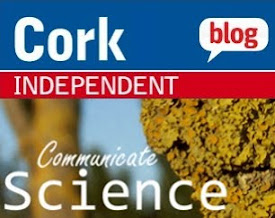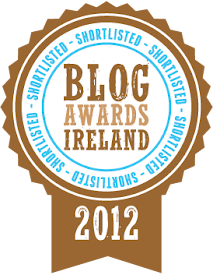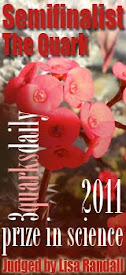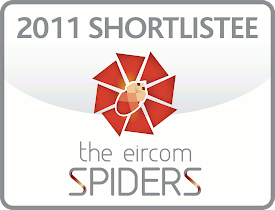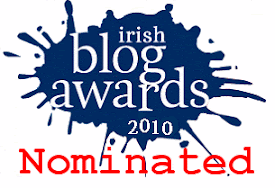BBC Science Club and Plant Blindness
The latest episode of Dara O'Briain's Science Club on BBC was all about extinction. The problem is, they seem to have killed off the plants before they even got started with the show.
The programme itself was excellent. The series has been largely well received and the move to a 'Topgear-style' format gives it a nice edgy and interactive feel to it. Dara O'Briain has also been engaging as our amusing guide to all things scientific.
My problem is that this week's episode was entirely zoocentric, without any mention of threatened plant species and their importance to the overall ecosystem.
There was an excellent studio piece on the African Clawed Frog and their former use as a rudimentary pregnancy test. Then we had a report on the Giant Panda and whether such "charismatic megafauna" are worth trying to save. We looked at the humble bee and also managed to find time to make a comet. All interesting TV but no mention of plants at all when talking about extinction? That seems a bit odd.
An EU report from 2008 showed that Europe is home to about 12,500 species of vascular plants (flowering plants, conifers and ferns). A staggering 21% of these species are threatened, according to the IUCN and 50% of plants which are only found in Europe are in danger of extinction. The main threats to Europe's wild plants are habitat loss, the introduction of alien species, the effect of pollution, the introduction of plant pests and diseases, and the effect of climate change. And that's just Europe alone!
It would have been nice to see the threat of extinction for plant species being discussed. After all, the solution to human-mediated extinction of animals is unlikely to be found without considering the overall impact of the environment the animal is living in and the plants which they are using for food and cover. It's all connected.
It seems, while outlining the the problem of conservationists becoming distracted from the bigger picture by the Giant Panda and other charismatic megafauna, the programme makers got distracted from looking at extinction in a broad sense and took the animal route alone.
I guess we can chalk this up as an example of 'Plant Blindness' a term coined to describe the inability of some to see the importance of plants in their lives and to the natural world in general. I talk about the importance of avoiding plant blindness in an article in the Winter edition of Walton Magazine. You can read it for yourself here.
Below, a clip from Tuesday's show: A Dodo's Guide to Extinction
The programme itself was excellent. The series has been largely well received and the move to a 'Topgear-style' format gives it a nice edgy and interactive feel to it. Dara O'Briain has also been engaging as our amusing guide to all things scientific.
My problem is that this week's episode was entirely zoocentric, without any mention of threatened plant species and their importance to the overall ecosystem.
There was an excellent studio piece on the African Clawed Frog and their former use as a rudimentary pregnancy test. Then we had a report on the Giant Panda and whether such "charismatic megafauna" are worth trying to save. We looked at the humble bee and also managed to find time to make a comet. All interesting TV but no mention of plants at all when talking about extinction? That seems a bit odd.
An EU report from 2008 showed that Europe is home to about 12,500 species of vascular plants (flowering plants, conifers and ferns). A staggering 21% of these species are threatened, according to the IUCN and 50% of plants which are only found in Europe are in danger of extinction. The main threats to Europe's wild plants are habitat loss, the introduction of alien species, the effect of pollution, the introduction of plant pests and diseases, and the effect of climate change. And that's just Europe alone!
It would have been nice to see the threat of extinction for plant species being discussed. After all, the solution to human-mediated extinction of animals is unlikely to be found without considering the overall impact of the environment the animal is living in and the plants which they are using for food and cover. It's all connected.
It seems, while outlining the the problem of conservationists becoming distracted from the bigger picture by the Giant Panda and other charismatic megafauna, the programme makers got distracted from looking at extinction in a broad sense and took the animal route alone.
I guess we can chalk this up as an example of 'Plant Blindness' a term coined to describe the inability of some to see the importance of plants in their lives and to the natural world in general. I talk about the importance of avoiding plant blindness in an article in the Winter edition of Walton Magazine. You can read it for yourself here.
Below, a clip from Tuesday's show: A Dodo's Guide to Extinction
Best of the web
- Migliori Casino Online Italia
- Casino Sites Not On Gamstop
- Casino Europei Online
- Siti Scommesse Non Aams 2025
- Migliori Casino Non Aams
- UK Casinos Not On Gamstop
- Casino Not On Gamstop
- Casino Sites UK
- Non Gamstop Casino Sites UK
- Meilleur Casino En Ligne
- Non Gamstop Casino Sites UK
- Gambling Sites Not On Gamstop
- Best Casinos Not On Gamstop UK
- UK Casinos Not On Gamstop
- Best Non Gamstop Casinos
- Melhores Cassinos Online Do Mundo
- Non Gamstop Casinos
- UK Casino Not On Gamstop








